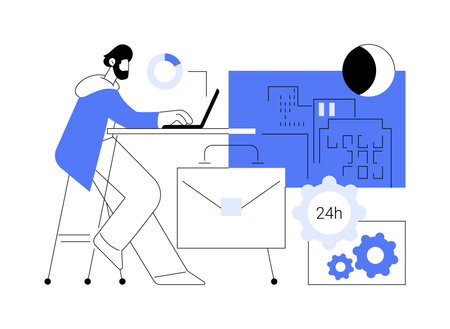Understanding the Panel Interview Format
If you’re preparing for a panel interview in the U.S., it’s important to know what to expect and why companies use this approach. Let’s break it down so you feel confident walking into your next group interview.
What is a Panel Interview?
A panel interview is when you meet with multiple interviewers at once, instead of just one person. This format is common in American workplaces, especially for roles that require teamwork or cross-department collaboration.
Why Do Companies Use Panel Interviews?
- Diverse Perspectives: Different team members can assess your fit from various angles.
- Efficiency: It saves time by bringing everyone together for one meeting.
- Consistency: Everyone hears your answers directly, reducing bias and miscommunication.
Typical Panel Interview Structure in the U.S.
| Panel Size | Common Participants | Main Focus |
|---|---|---|
| 2-5 people | – Hiring Manager – HR Representative – Potential Team Members – Cross-functional Colleagues (like IT or Marketing) |
– Skills and Experience – Culture Fit – Problem-solving Abilities |
What Happens During a Panel Interview?
- You’ll be introduced to each panel member at the start.
- Questions are often rotated among the panelists, with each focusing on their area of interest.
- You may be asked behavioral questions, situational scenarios, or even technical problems relevant to the job.
- The setting might feel formal or conversational, depending on the company culture.
Understanding these basics will help you approach your next panel interview with confidence and clarity.
2. Researching Your Panel and Company Culture
Why Panel and Company Research Matters
Panel interviews are all about teamwork and fit. Understanding who you’ll be meeting and what the company stands for gives you a big advantage. By researching both the panelists and the company, you show genuine interest and prepare yourself to connect your skills to their needs—just like American professionals do.
How to Research Your Interview Panel
Start by finding out who will be on your interview panel. You can usually ask your recruiter or check your interview invite for names. Once you have them, look them up on LinkedIn or the company website. Pay attention to their job titles, backgrounds, and even any shared connections or interests. This helps you tailor your answers and questions during the interview.
| Panelist Name | Role/Department | Key Interests/Expertise |
|---|---|---|
| Susan Lee | HR Manager | Diversity & Inclusion, Team Building |
| David Kim | Engineering Lead | Product Development, Agile Methods |
| Tina Brown | Marketing Director | Brand Strategy, Social Media Trends |
Tips for Learning About Panelists:
- Review their recent projects or achievements on LinkedIn.
- Note any articles, blogs, or public talks they’ve shared.
- If appropriate, mention a shared interest during the interview to build rapport.
Uncovering Company Values and Culture
The U.S. workplace values diversity, innovation, and open communication. To understand how this shows up at your target company, start with their official website—especially the “About Us” and “Careers” pages. Look for statements about mission, vision, and core values. Employee reviews on sites like Glassdoor can also give you a sense of day-to-day culture and what employees appreciate most.
| Resource | What to Look For |
|---|---|
| Company Website | Mission statement, leadership bios, recent news releases |
| LinkedIn Page | Company updates, employee spotlights, community involvement |
| Glassdoor/Indeed Reviews | Employee feedback on management style, work-life balance, benefits culture |
| YouTube/Social Media | Cultural events, team activities, company values in action |
Cultural Norms in U.S. Workplaces:
- Punctuality is highly valued—arrive early for interviews.
- Teamwork and clear communication matter more than hierarchy.
- Diversity of thought is welcomed; don’t be afraid to share your perspective respectfully.
- Prepare examples that highlight adaptability, problem-solving, and collaboration.
This research not only helps you answer questions confidently but also allows you to ask thoughtful questions of your own—showing you’re ready to thrive in an American group setting.

3. Crafting Impactful Responses
When you’re facing a panel interview, your answers need to resonate with a variety of people—each with their own priorities and perspectives. Here’s how you can master techniques for tailoring your responses, use the STAR method to tell compelling stories, and show exactly why you’re the right fit for the organization.
Understanding Your Panelists
Each panelist often represents a different department or interest. Take a moment to observe their introductions and body language. This awareness helps you address what matters most to them. For example, an HR representative might care about culture fit, while a technical manager focuses on skills.
| Panelist Role | What They Value | How to Address |
|---|---|---|
| HR Manager | Teamwork, values, communication | Mention collaboration and company culture alignment |
| Department Head | Technical skills, results | Highlight technical achievements and measurable impact |
| Potential Teammate | Work style, interpersonal skills | Share stories about teamwork and adaptability |
| C-Suite Leader | Big-picture thinking, company goals | Connect your work to organizational success |
Weaving in STAR Stories for Maximum Impact
The STAR method (Situation, Task, Action, Result) is your go-to for answering behavioral questions clearly and memorably. It keeps your answers focused and easy for everyone on the panel to follow.
- Situation: Briefly set the scene.
- Task: Explain your responsibility or challenge.
- Action: Describe what you did specifically.
- Result: Share the outcome—ideally with numbers or direct impact.
Example:
“Last quarter, our team faced a tight deadline (Situation). As project lead, I was responsible for coordinating between departments (Task). I set up daily check-ins and prioritized urgent tasks (Action). We finished the project three days early and reduced costs by 10% (Result).”
Demonstrating Your Fit with the Organization
Your responses should connect your experience and values with the company’s mission. Do some homework before the interview—know what the company stands for and mention specific reasons you feel aligned with their culture. Use phrases like:
- “I’m excited about your commitment to innovation because…”
- “Your focus on community involvement really resonates with me.”
- “I see a lot of alignment between my approach to problem-solving and your team’s values.”
Tying It All Together in Real Time
Aim to make eye contact with each panelist as you answer. Reference earlier questions or comments from other panelists when possible—it shows active listening and engagement. For example: “As Sarah mentioned earlier about cross-departmental collaboration…”
Your Panel Interview Playbook at a Glance:
| Step | Tip |
|---|---|
| 1. Read the Room | Identify panelists’ interests early on. |
| 2. Customize Answers | Tweak examples to match panelists’ roles. |
| 3. Use STAR Method | Tell clear stories with real impact. |
| 4. Show Cultural Fit | Name specific company values you share. |
This approach will help you stand out confidently in any group interview setting by showing both your expertise and your genuine connection to the organization.
4. Building Rapport and Engaging the Group
Understanding U.S.-Specific Interpersonal Skills
In American panel interviews, how you interact with each panelist can make a big difference. U.S. workplace culture values clear communication, approachable body language, and respect for different viewpoints. Showing these qualities helps you build rapport quickly, making you more memorable to your interviewers.
Key Interpersonal Skills in the U.S.
| Skill | Description | Example in Interview |
|---|---|---|
| Eye Contact | Shows confidence and honesty; avoid staring, but do look at each person as you speak | When answering a question, glance at everyone on the panel, not just the one who asked it |
| Active Listening | Nod, smile, or use short verbal cues (“Absolutely,” “I see”) | Acknowledge points made by different panelists and refer back to them in your responses |
| Open Body Language | Sit upright, keep arms relaxed, and face the group | Avoid crossing arms or looking at your phone or notes excessively |
| Polite Assertiveness | Share your ideas confidently but respectfully; don’t interrupt others | If two people speak at once, politely say, “I’m happy to answer that right after you finish” |
Connecting With Your Audience: The Panel Members
Think of the panel as your audience. In a group setting, your goal is to connect with each member—not just the one who asks you questions. Start by learning their names and roles if possible. Use names during the conversation (“That’s a great point, Maria”), which feels warm and personal in American culture.
Tips for Making a Connection:
- Use Inclusive Language: Phrases like “As we all know,” or “From what I understand about this team…” show you’re thinking about the whole group.
- Balance Your Attention: Don’t focus too much on one person; make sure everyone gets some eye contact and engagement.
- Acknowledge Different Perspectives: If panelists offer different views, recognize both sides: “I appreciate both perspectives; here’s how I would approach it…”
- Mention Shared Goals: Refer to company values or mission statements if relevant—this shows alignment with group priorities.
Navigating Group Dynamics During Conversation
You may notice different personalities on the panel—some are talkative, some quieter. A successful candidate adapts by encouraging input from everyone. For example, if someone hasn’t spoken much, you might say, “I’d also love to hear your thoughts on this.” This demonstrates strong interpersonal skills highly valued in U.S. workplaces.
Common Panel Member Types and How to Engage Them:
| Panelist Type | How to Engage Them |
|---|---|
| The Leader (often starts the meeting) | Acknowledge their role by thanking them for organizing; respond thoughtfully to their questions. |
| The Subject Matter Expert (asks technical questions) | Dive deeper into specifics when they engage; reference shared knowledge or experiences. |
| The Observer (quiet, takes notes) | Make occasional eye contact; invite their opinion if appropriate. |
| The Culture Champion (talks about company values) | Mention how your own values align with theirs and share relevant examples. |
By mastering these strategies tailored for American workplace culture, you’ll stand out in any panel interview—showing not just what you know but how well you can connect and collaborate with a diverse group.
5. Excelling in Q&A and Following Up Professionally
Sharpening Your Approach to Panel Questions
Panel interviews can feel like rapid-fire questioning, but with the right strategy, you can handle questions from multiple interviewers smoothly. Here are some practical tips:
- Stay Present and Attentive: Make eye contact with the person asking the question, but also include other panel members by occasionally glancing at them as you respond.
- Take a Brief Pause: Before answering, take a moment to process the question. This shows thoughtfulness and helps you avoid rushing your response.
- Name Drop Strategically: If you remember a panelist’s name, use it when addressing their question. For example, “That’s a great point, Sarah.”
- Clarify if Needed: Don’t hesitate to ask for clarification if a question is unclear. It’s perfectly acceptable in American business culture to say, “Just to make sure I understand, are you asking about…?”
Handling Curveball Questions
You might get unexpected or tough questions. Here’s how to manage them confidently:
| Type of Curveball Question | How to Handle |
|---|---|
| Hypotheticals (“What would you do if…?”) | Outline your thought process step-by-step before giving an answer. |
| Behavioral (“Tell us about a time when…”) | Use the STAR method: Situation, Task, Action, Result. |
| Skills Gaps (“You don’t have experience with X. How will you cope?”) | Acknowledge honestly, then highlight transferable skills and willingness to learn. |
| Cultural Fit (“How would you handle conflict on our team?”) | Share examples that show emotional intelligence and teamwork. |
Sample Responses for Tough Questions
- If you don’t know the answer: “That’s an interesting question. While I haven’t encountered that exact situation before, here’s how I would approach it…”
- If you need more time: “Let me think about that for a second.” (A brief pause is respected.)
Best Practices for Professional Follow-Up
A thoughtful follow-up sets you apart in American business culture. Here’s what to do after your panel interview:
- Send Thank You Emails Within 24 Hours:
- Email each panelist individually if possible.
- Mention something specific from your conversation with them.
- Keep It Concise and Genuine:
- No need for lengthy messages—just express appreciation and reiterate your enthusiasm for the role.
- If You Forgot a Question or Want to Add Info:
- Your thank-you note is a good place to briefly address any missed points or provide additional information relevant to your interview.
Email Template Example
Subject: Thank You – [Job Title] InterviewHi [Panelist Name],Thank you for meeting with me today. I enjoyed discussing [specific topic] and learning more about [company/team/project]. I’m excited about the opportunity to contribute my skills in [area] to your team.Please let me know if there’s anything else I can provide.Best,[Your Name]

